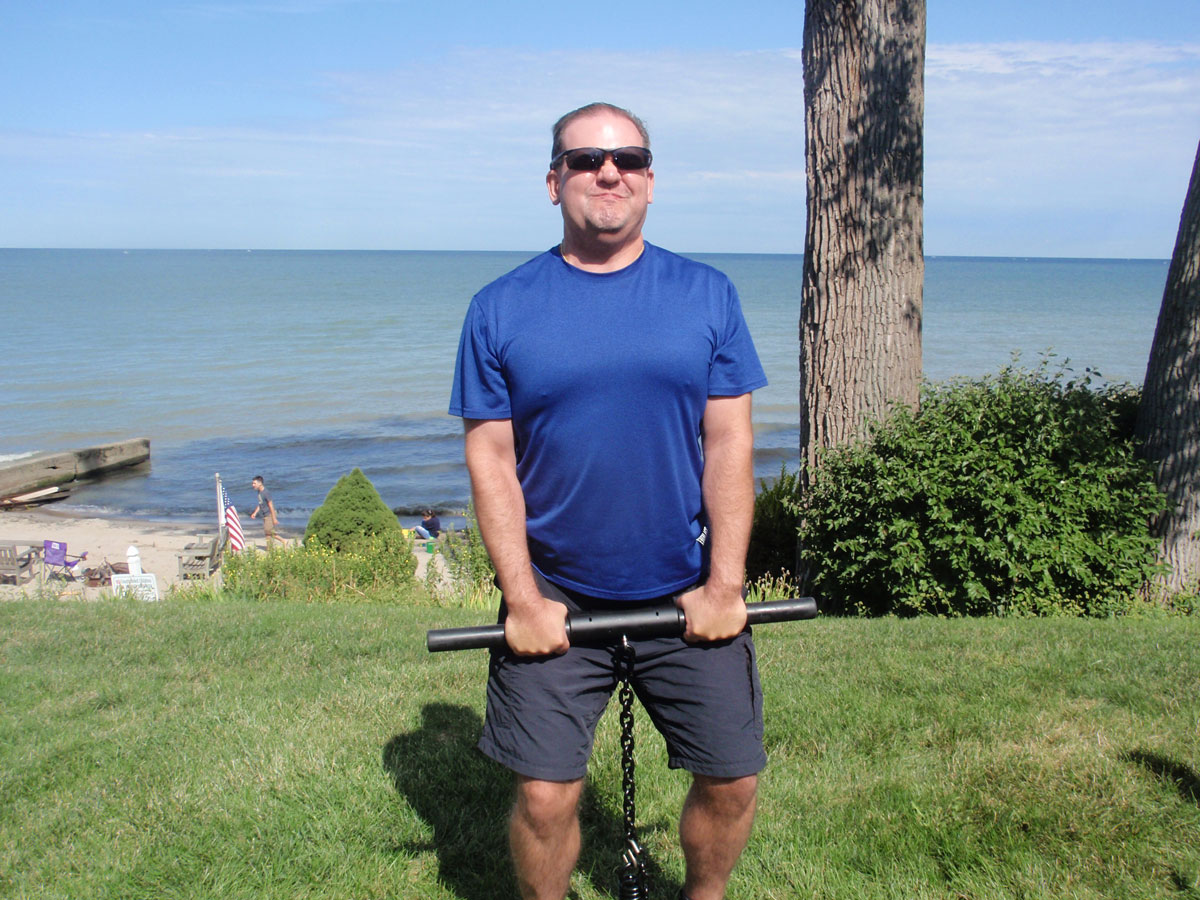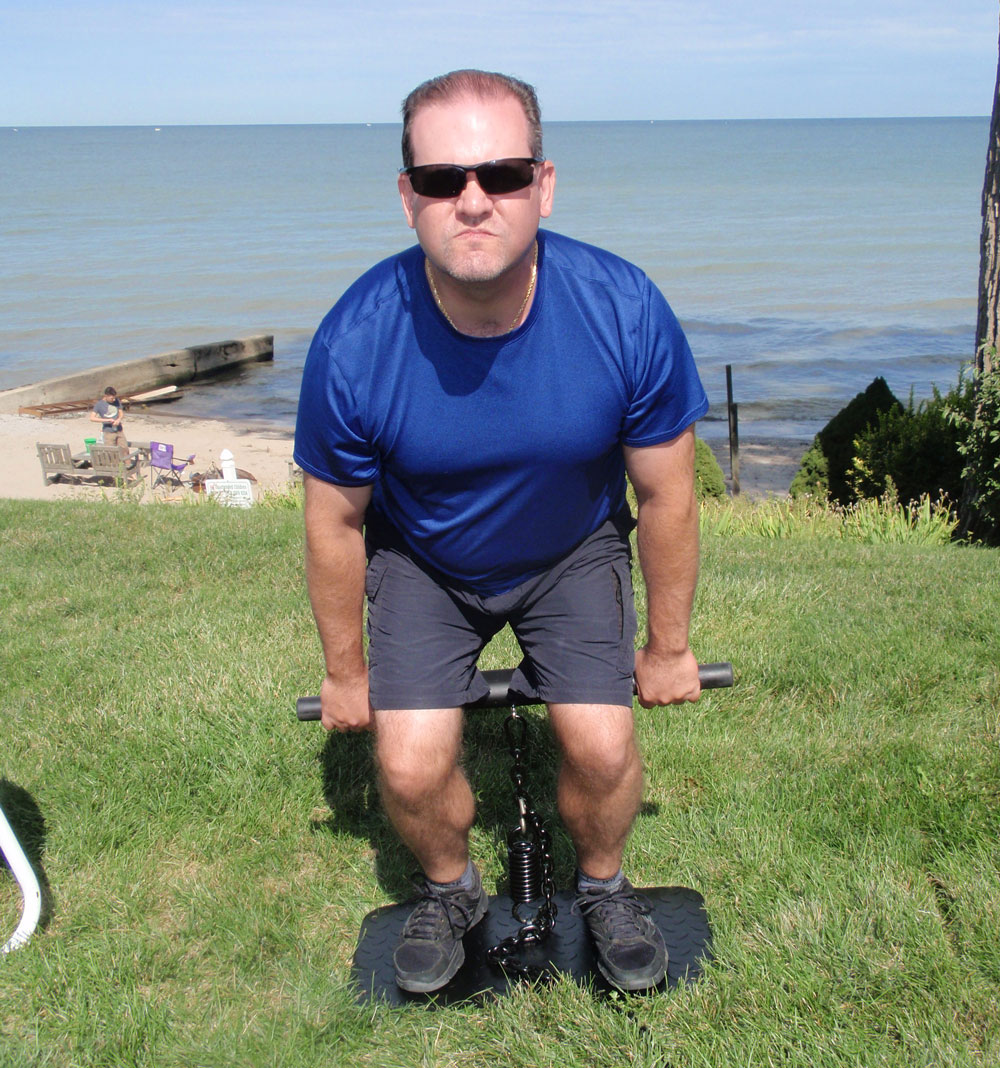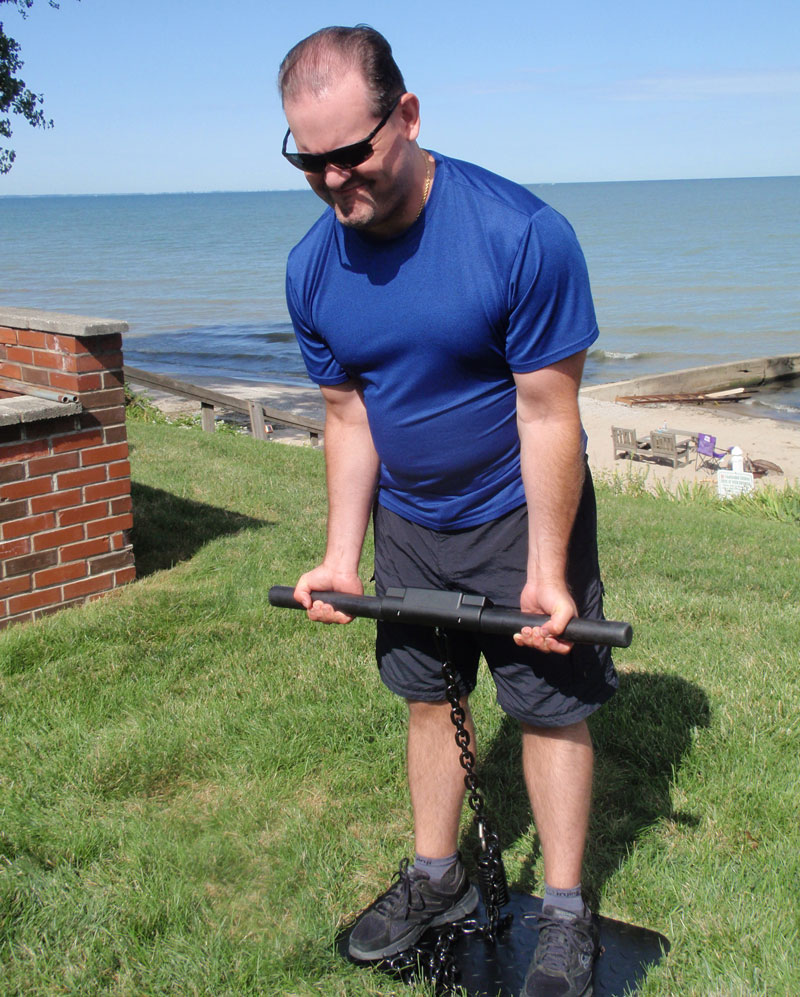The Isochain 4-Week Strength Gain Challenge
by John McKean
 Rob demonstrates the ISOCHAIN hand and thigh lift
Rob demonstrates the ISOCHAIN hand and thigh lift
"Beat the book regularly, and you'll eventually conquer the world!" was the definitive statement often repeated by my Olympic-style weightlifting friend, Don Booth. Don was a staunch believer in maintaining consistent, meticulous written records of every training session, down to exact poundage, set, and rep. His philosophy: Always keep an eagle eye on continued progression of weight and increased workload through an ever-present training log. This always worked well for him — except during one short but very meaningful period.
Throughout that eight-week time frame, Booth HAD to keep his famous "book" unnumbered and essentially blank. Why? Well-known in a southwest U.S. iron game community for his success with overhead lifts, Don inexplicitly decided to enter his first powerlifting contest. Ridiculed immediately by the event's promoter of that state championships, Mr. Booth was pointedly informed he had no chance whatsoever of winning — or even placing. After all, the meet director himself, lifting in Don's 181-pound division, owned the state record squat. Another local fellow held the bench press record, and a third lifter, yet another 181er, was the big deadlifter in those parts. Carefree Don just smiled and agreed, mentioning he merely wished to enjoy experimenting and he'd return in two months.
During his subsequent training time with his home basement power rack, Don decided to only perform nine all-out pure isometrics. Using just a bare Olympic bar, he jammed it into upper, non-yielding, solid rack pins. Three positions were secured for the squat, bench press, and deadlift for 20 seconds each of mind-numbing, blood vessel expanding push or pulls. Hence, no actual numbers needed to be written in his otherwise crowded training book!
On the day of the state championships, Booth arrived confidently with the blank training book nestled in his gym bag. He soon discovered the meet director's prediction was, in part, absolutely correct. Don came in second in the squat, couldn't top the bench presser, and was a bit behind the contest's big puller.
However, my old friend OUT-TOTALED all three! Guess who took home the trophy?
Oh, how Don enjoyed returning to scribbling in his training log after that meet! He claimed that working with the numbers always made him feel so smart!! But if he would have had an
Isochain back then, with its instant feedback, he probably would have stuck to isometric training for the rest of his days!
Fortunately, John Du Cane recently assigned my son Rob & I a month-long project of both instantaneous NUMBER awareness of our strength gains, PLUS keeping a book of those numbers. For us, it made isometrics come alive!
Our four-week mission was simply to record progress on four All-Round lifts of our own choosing. Rob went with the hand and thigh, press behind the neck, curl, and wrist curl. I selected the Kennedy lift (an 18" off floor start Straddle), the Lurich (18" high start hack), power row, and the wrist curl.
 Rob demonstrates the ISOCHAIN Lurich lift
Rob demonstrates the ISOCHAIN Lurich lift
As a former career math teacher, I know full well that a big list of statistics would totally bore readers, so instead I'm going to list just percentage increases. This should be much more meaningful to future
Isochain trainees as to what is possible for their own particular lifts/poundages.
So here are the gains from these past four weeks:
Rob – H&T +56%, Curl + 37%, Press behind neck +42%, Wrist curl + 22%
John – Row +16%, Kennedy +21%, Lurich +17%, Wrist curl +3%
Understand that Rob is now middle-aged (41) and I'm ancient at nearly 75. You, more than likely younger with superior recuperation, should be able to achieve much better results! Plus, in my defense, I was concentrating on rehabbing some physical ailments with the particular lifts I selected (especially my still damaged wrist — but showed improvement, nevertheless, and stimulated healing).
Now, these gains had their minor ups and downs, as does any standard weightlifting cycle. But if I were to draw a line graph, our progress would appear much like the U.S. stock market during the past four years — a steady, steep upward curve.
However, some interesting
Isochain observations presented themselves. For instance, we soon noted in some lifts that we couldn't initially produce the poundages we'd had in actual weightlifting competitions. Sticking point positions, especially without momentum or "stretch reflex," simply cannot produce that speedy display of force as in a full range movement. Then too, the
Isochain bar itself was thicker than a normal standard Olympic bar — a real plus, IMO, for simultaneously building grip strength, but it did reduce (at first) the utmost pulling pressure for deadlift types.
As we usually partnered during training sessions, Rob and I both found extreme enthusiasm in pressing that "limit" button whenever a hold was complete. As former competitive lifters, this was our major focus over the month, and enabled us to visually (the digital screen!) push each other to peak performance. Rob went for three sets of holds per lift, while I generally employed two sets; both of us wanted to ensure we didn't shortchange our iso hold time, even with the beep telling us that we had done enough!
Interestingly, it was universal throughout all lifts, that the first set almost always produced the best effort, by the numbers. Perhaps those original power rack old timers, Dr. John Ziegler, Bill March, and Lou Riecke, had it right in discovering that one all-out six second push was best for pure strength gains! Still, we enjoyed going for the second or third set to see if we could possibly beat the first. Sometimes we did manage more, and that gave delight that a true max was reached for that day.
It might be mentioned that from my longtime use of power rack isometrics with barbells that, though I once strived to add more weight to achieve a perceived top daily hold, it was always a guessing game. Now I don't just imagine or hope to push up a true max, but use the incentive of the
Isochain to go all-out during every six second "set" in achieving a sincere, absolute best number every time. Nothing, I've found, inspires me to try harder with isometrics than to "beat the book" each workout, as seen on my Isochain digital! I just love to press that limit button for discovery and instant gratification of my effort!!

Some may ask why we didn't just watch the readouts during each lift? Well, usually the position of the bar wouldn't allow this, but mostly when "going for broke," teeth are gritted, eyes are closed, and your head is exploding! Heck, my concentration is so overwhelming that I can't even hear the time mode beeping! (Of course, my family claims in my old age that I can never hear anything!!) Yet the liveliness of the
Isochain is such that we can FEEL the slight give of the heavy duty spring, the minor flex of the steel base, and even a hint of the bar bending — this provides incentive to try to obtain even a 1/16 inch more "yield" from our unit!
Geez, like my old pal Don Booth, I'm feeling so much more mathematically clever these days from all this recent number/percentage "booking" — and so much stronger to boot!
John McKean has won multiple local, state, national powerlifting titles, Masters Olympic national titles, and national and world all-round titles during the past 50 years. He has written extensively for all major strength magazines starting with Strength & Health under John Grimek and was featured in Dr. Len Schwartz's famous book Heavyhands Walking. A certified instructor in flex band training and American Combatives, Mr. McKean offers his consulting services at memck487@aol.com
Back